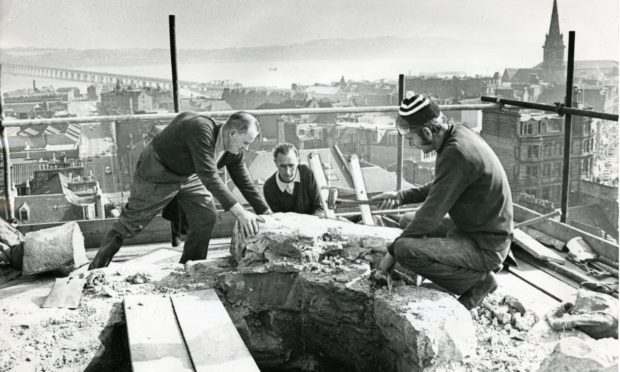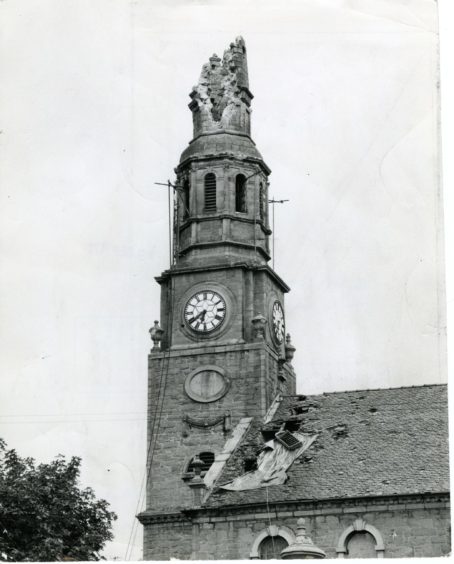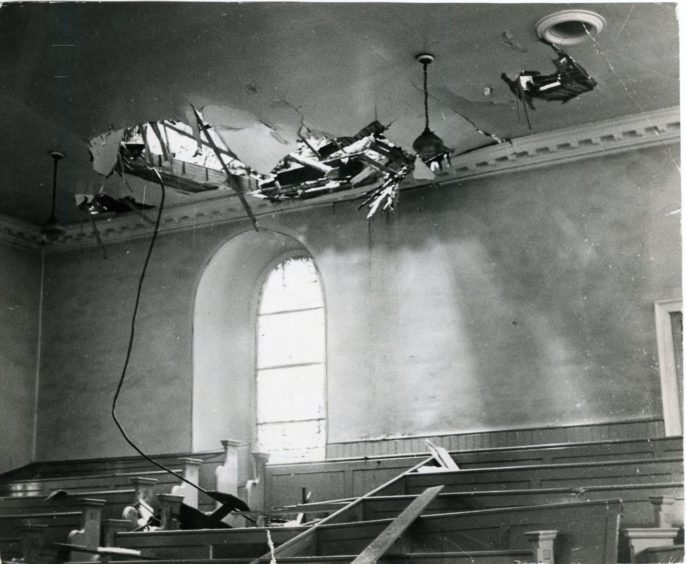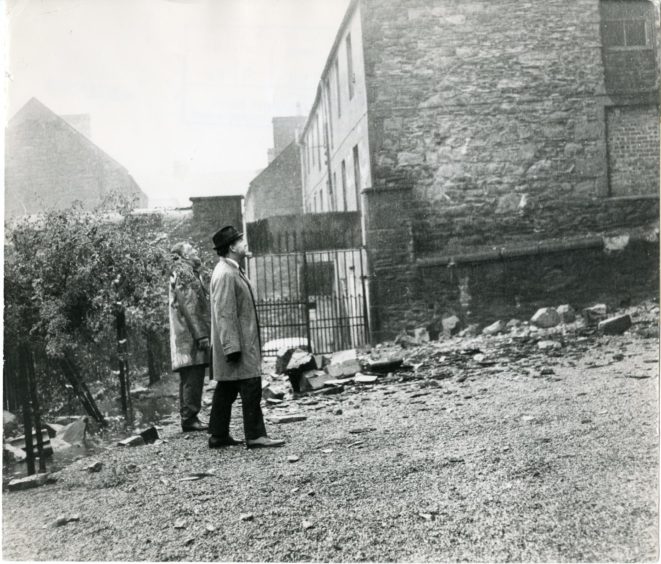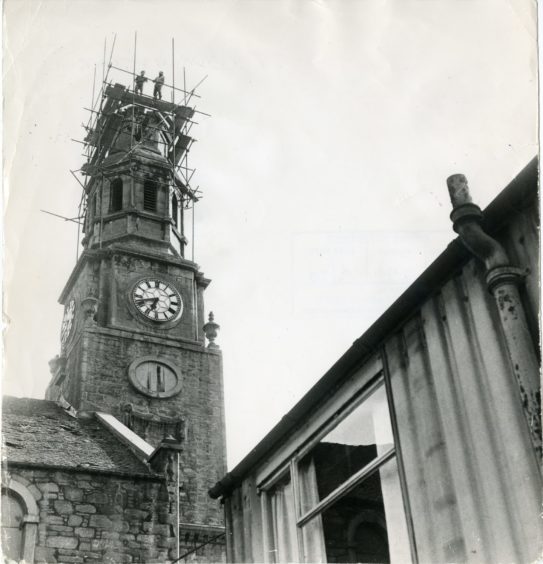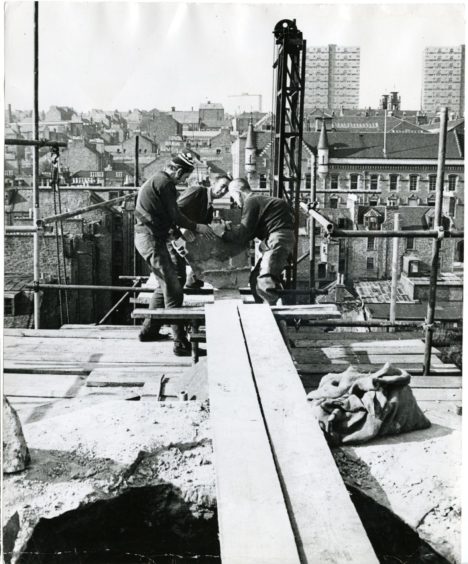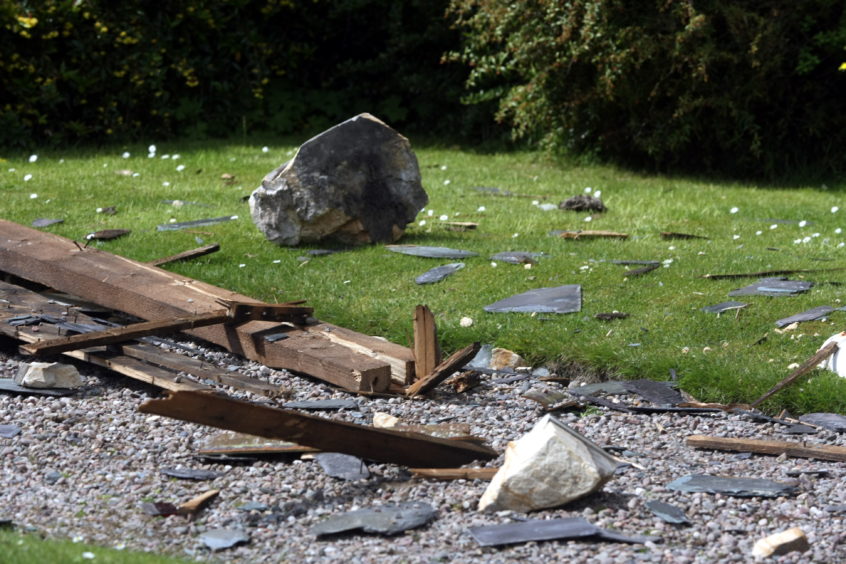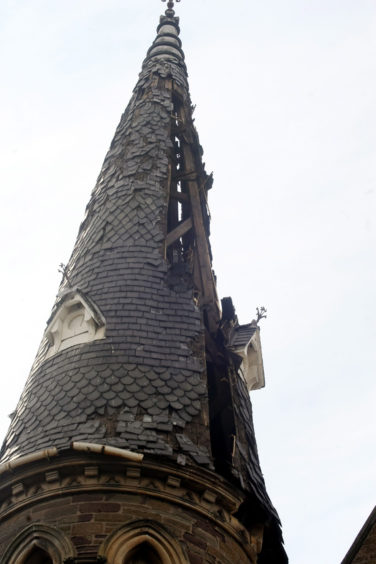It was the thunderstorm “ten times louder than the Concorde boom” which brought terror to Dundee 50 years ago.
The steeple of St Andrew’s Church in Dundee was struck by lightning and three men escaped being killed when tons of masonry crashed on to the van they were unloading and split it in two.
St Andrew’s Church lightning strike
The drama happened during a fierce 90-minute thunderstorm on September 8 1970 which brought biblical-style downpours and flooding.
About 30 feet of the spire was sliced off, sending tons of masonry crashing down on to the church roof and a derelict warehouse.
The steeple just disintegrated.
The thunderclap accompanying the flash which slashed the steeple was described by one witness as “ten times louder than the Concorde boom”.
Three men were unloading TV sets at the rear of Watt’s Ltd in Wellgate when a radio which was playing inside the store blew up as the lightning lit the sky.
The men raced inside and seconds later the rubble crashed down from the steeple.
The van was thrown 15 feet across the pend and split in two.
It contained six TV sets and radio stock which was valued at £1,000.
Another van was hit by masonry and the rear end was crushed and the windscreen shattered.
A car belonging to a director of the firm was also badly damaged.
A fourth employee also escaped injury by inches.
The basement was flooded and he had gone out into the pend to a small garage to get a pair of wellies.
He just stepped back inside the door of the store again when the masonry crashed down.
No one was injured although four people were thrown back by the tremendous blast.
They were standing 80 yards away from the steeple at the entrance to David McLardy and Co in King Street.
“It was absolutely blinding,” said George Minto.
“We closed our eyes and the next thing we knew we were lying on the steps leading into the shop.”
More than an hour after the blast he was still suffering from slight deafness.
Margaret McMurdo, a cleaner in the shop, had her glasses blown off.
“There was this amazing flash,” she said.
“I don’t remember anything else.
“I finished on my back.”
Frank Nichols said: “We will never be nearer a catastrophe in all our lives.
“I just can’t explain the brightness and the sound of the steeple coming down.”
The fourth person caught in the blast was David Valentine.
“I had to close my eyes,” he said.
“None of us saw the steeple come down because by the time we recovered ourselves there was nothing but a cloud of dust.”
There were two gaping holes left in the church roof.
One measured about 15 feet by eight feet and the other was slightly smaller.
Gallons of rain started pouring through into the church although the blast failed to upset the clock midway down the steeple which was still ticking away.
Drains in the area burst and showered water high into the air.
The water built up to knee height in some places.
King Street was impassable as the torrent of water raged down the hill.
Many people stripped off their socks and shoes and cars ground to a halt.
A light drizzle turned to a merciless downpour just after 10am.
The Nethergate pedestrian tunnel at the south side of Marketgait roundabout was flooded and impassable.
Trades Lane was closed and traffic piled up in Marketgait.
Roads around the Seagate bus station were flooded and passengers arriving were unable to leave the station.
In Mary Ann Lane, which runs from Seagate to Dock Street, people were marooned in offices and warehouses.
A couple managed to escape when they climbed into the bucket of a mechanical digger which drove through the flood water to rescue them.
In the Overgate, shops had to close their doors.
There was also damage to paintings and antiquities which were worth thousands of pounds and were housed in the basement of the Albert Institute.
There were anxious moments in Meadow House, Reform Street, when two feet of flood water surrounded an electricity transformer in the basement.
The fire brigade were called to pump the water away.
Over 150 pupils at Craigiebarns Primary were sent home for the day and workmen used sand to stop the water seeping into the classrooms.
All 510 children of Mossgiel Primary in Linlathen had to have their dinner at school.
Children at Linlathen High School were hoisted over the fence to get out because the gateway was flooded.
Flooding was also reported in Hilltown and on low-lying roads in Broughty Ferry and Barnhill.
Other flood areas were Riverside Drive, West Clepington Road, Drumlanrig Drive, Old Glamis Road, Strathmartine Road and Finlaggan Crescent.
“A stern reminder of a 1970s act of God”
St Andrew’s Church was completed in 1774 after it was felt that another place of worship was required due to the rapid increase in population within the Dundee area.
A large proportion of the community were members of the Trade Corporations who took an active interest in the welfare of the town, with particular interest in the work of the church.
The town council was approached and refused to make any financial contribution to the erection of another church.
It was left to the Trades to take the responsibility for the funding of the church, and in 1774 under the Dundonian architect, Samuel Bell, the church was completed.
Bell designed most of Dundee’s public buildings from 1770 until his death in 1813.
His style was ‘provincial and not very up-to-date’ but the buildings were attractive and Palladian in character with some details borrowed from the Adam brothers.
When it was built in the 18th century the area was semi-rural.
Today, the church is dwarfed by the Wellgate Centre and is still the scene of the colourful “Kirkin of the Trades” which is held in November.
The church is rectangular, built in rubble, perhaps originally harling, with fine stone dressing, twin Venetian windows with ionic pilasters and swags above.
There are arched doorways on either side of the central windows and two tiers of smaller arched windows.
The spire rises to 139 feet.
There is a memorial on the front of the building to the Reverend Harcourt Morton Davidson, minister from 1886 to 1926 who is buried under the pulpit.
The communion table was gifted by the Taylor family in memory of Captain Norman Taylor, MC, who was killed in action in 1917 during the First World War.
When lightning struck the church steeple in 1970, it was also deemed necessary to remove the original bells.
They hadn’t rung since 1950.
They were taken to a resting place outside the east door of the church where they sit to this very day.
The cost of rebuilding the steeple with original stone, even if the Craigie quarry had still been functioning, would have been prohibitive following the lightning strike.
Compromise resulted in a man-made substitute, enclosing a central core of polystyrene and lightweight concrete.
The Rev T. R. S. Campbell said at the time: “As age continues to weather the natural stone below, the difference becomes more marked, a stern reminder of a 1970s act of God.”
Lightning really does strike twice
Bolts from the blue four decades later caused £350,000 of damage to St Stephen and West’s steeple in Broughty Ferry in May 2010.
The church was designed by Dundee architect Thomas Robertson and it was opened in late 1871.
The steeple took the full brunt of the lightning strike and sustained extensive damage with roof tiles, timber and masonry raining to the ground.
An initial assessment by the city engineer determined the structure of the spire was still sound and church representatives held a series of meetings to co-ordinate the repair operation.
The blast and the huge rumble of thunder that accompanied the lightning was heard throughout Broughty Ferry and left a number of homes and businesses without power.
Emergency measures were carried out in the immediate aftermath to make the structure safe and protect the church from the elements.
However, engineers found more structural problems than anticipated.
The requirement for the work to be carried out in-keeping with the historic nature of the 1871 building caused further delays.
As a result it was several months before the spire was stripped back to its skeleton to allow reconstruction to begin in earnest.
In the meantime, after a brief period joining parishioners at nearby St Luke’s and Queen Street Church, worshippers were allowed back to hold services in the church hall.
The restoration was carried out to the approval of conservation officers after lengthy discussions and negotiations.
Insurance covered 60% of the £350,000 bill, leaving the church to pick up the remaining £140,000.
The balance was met from the proceeds of the sale of the manse, which was put on the market when the previous minister Dr John Cameron retired, boosted by the fundraising efforts of church members.
